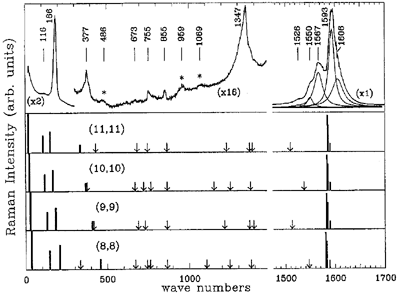
A. M. RAO,a,b E. RICHTER,a Shunji BANDOW, Bruce CHASE,c P. C. EKLUND,a,b K. A. WILLIAMS,a S. FANG,a K. R. SUBBASWAMY,a M. MENON,a A. THESS,d R. E. SMALLEY,d G. DRESSELHAUSe and M. S. DRESSELHAUSe (aUniv. Kentucky, bCenter for Appl. Energy Res., cDupont, dRice Univ. and eMIT)
[Science 275, 187 (1997)]
Single wall carbon nanotubes (SWNTs) that are found as close-packed arrays in crystalline ropes have been studied by using Raman scattering techniques with laser excitation wavelengths in the range from 514.5 to 1320 nanometers. Numerous Raman peaks were observed and identified with vibrational modes of armchair symmetry (n,n) SWNTs. The Raman spectra are in good agreement with lattice dynamic calculations based on C-C force constants used to fit the two-dimensional, experimental phonon dispersion of a single graphene sheet. Calculated intensities from a nonresonant, bond polarizability model optimized for sp2 carbons are also in qualitative agreement with the Raman data (see Figure 1), although a resonant Raman scattering process is also taking place. This resonance results from the one-dimensional quantum confinement of the electrons in the nanotube.

Figure 1. Raman spectrum (top) of SWNT samples taken with 514.5 nm excitation at ~2 W/cm2. The * in the spectrum indicates features that are tentatively assigned to second-order Raman scattering. The four bottom panels are the calculated Raman spectra for armchair (n,n) nanotubes, n = 8 to 11. The downward pointing arrows in the lower panels indicate the positions of the remaining weak, Raman-active modes.